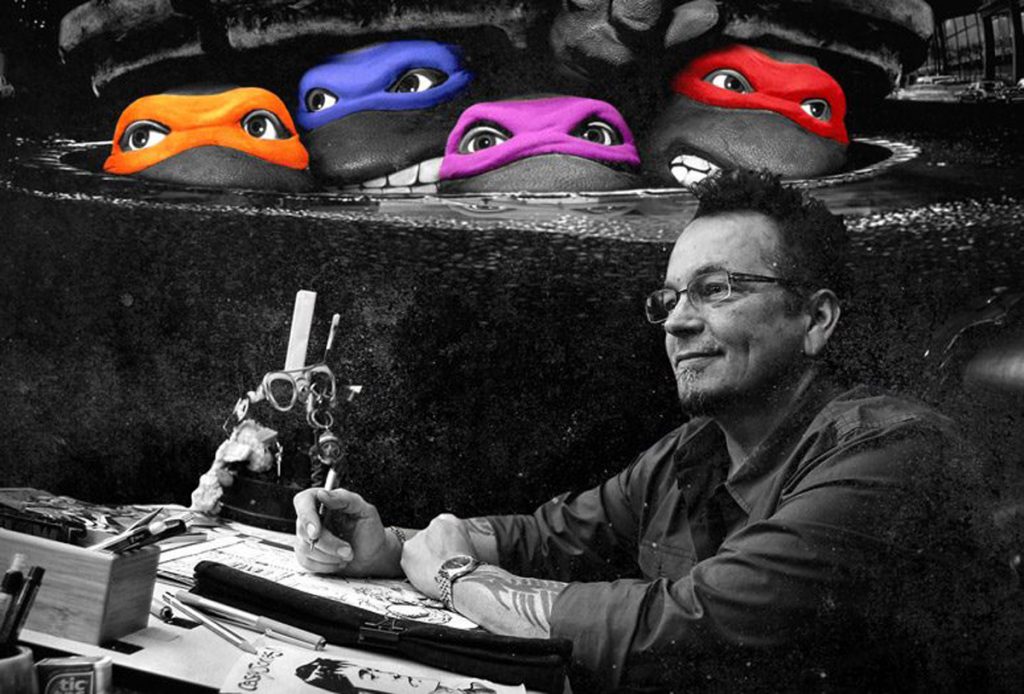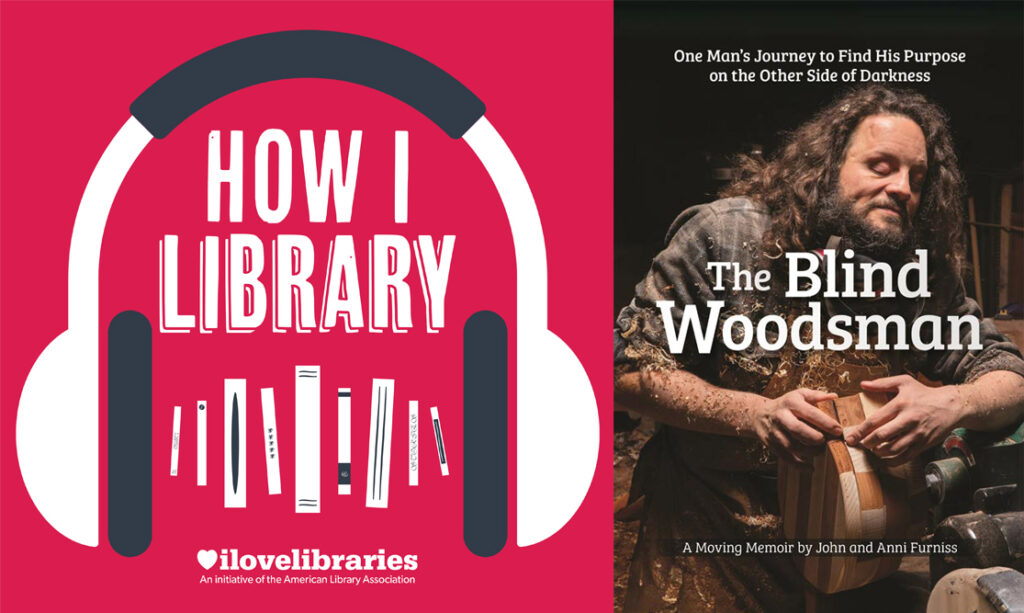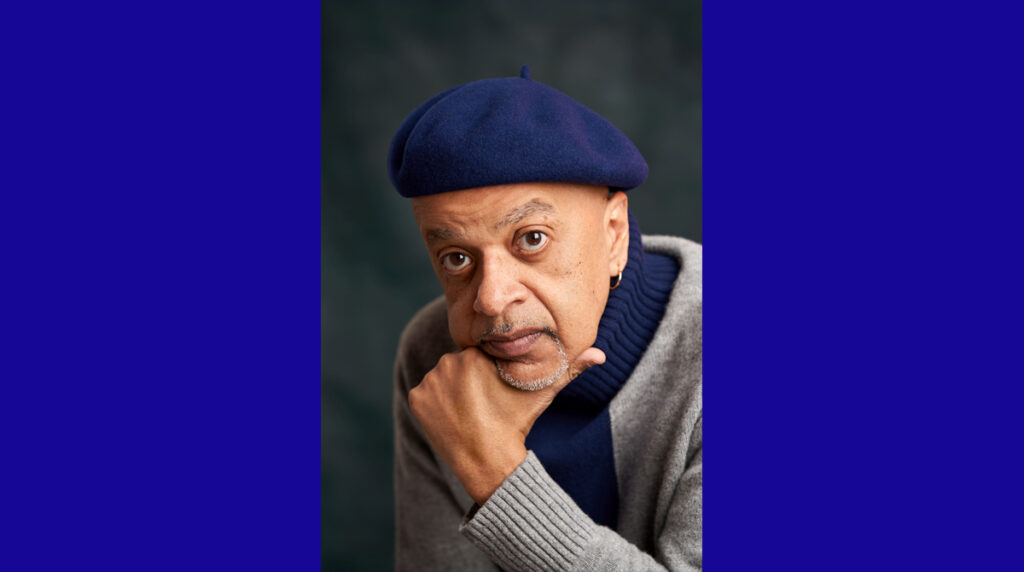There was a time when the names Michelangelo, Donatello, Raphael, and Leonardo conjured images of Italian Renaissance artists. But today, for many, those names are forever linked to the Teenage Mutant Ninja Turtles—a ragtag group of mutated, adolescent, martial arts-master turtles who fight crime from the sewers of New York City. Before they became film, TV, toy, and even breakfast cereal stars, these “heroes in a half-shell” could be found in the pages of their eponymous independent comic book, created in the early 1980s by artists and writers Kevin Eastman and Peter Laird.
I Love Libraries sat down with Eastman at the American Library Association’s 2022 Annual Conference in Washington, D.C., in June to discuss the Turtles and their origins, the importance of comic books as literacy tools, and the role of libraries in Eastman’s life growing up and today. We can think of no better way to spend National Comic Book Day!
When Teenage Mutant Ninja Turtles (TMNT) debuted in 1984, I was 10 years old and a big fan of DC Comics with their larger-than-life superheroes rendered in bright, over-saturated colors. I remember the arrival of TMNT—it changed everything. It was a weird and dark comic, with black and white imagery and stories that were intended for adults but funny enough to appeal to kids. TMNT changed how I—and comic book fans around the world—viewed and understood comics, storytelling, and art. And subsequently it went on to change the comic book and toy industry. When you were creating TMNT, did you have any idea that it might become a cultural phenomenon?
The creation of TMNT was about standing firmly on the shoulders of so many giants—mainstream artists who worked for Marvel and DC. Jack Kirby, in particular, was a huge influence. [TMNT co-creator] Peter Laird and I both tried to break into comics [and received] lots of rejection letters and that kind of stuff. And then I discovered two things: One was Heavy Metal magazine in 1977, which led to the discovery of self-publishers like Richard Corben and Vaughn Bodē and this whole world of underground publishers who couldn't break into mainstream. And that led to Dave Sim who did Cerebus the Aardvark, which was a black and white comic book with a two-color cover. He kind of parodied Conan the Barbarian with this funny animal that was running around acting like Conan. It was just hilarious and a wonderful parody. And we said, “We could do that. That's our way in.”
[We were drawn to] that approach of complete creative control—telling the story we wanted to tell with no boss, no editor, no anything but our passion and our influences to bring a story to life how we wanted. So, we borrowed money from my uncle to self-publish that first TMNT issue and expected to sell maybe a couple of dozen copies at best. But we had a beginning; we had a comic. And that was the most exciting thing in the world.
What it became from that point and how people discovered it, it was just something different. It was the time for something like this. And it was really a right place, right time opportunity.
Did the creation of the TMNT toy line and other parts of the franchise—the films, TV series, video games, etc.—influence the comic books and the characters themselves?
No, it really didn't have much of an effect. The ancillary things—the toys, the animated series which led to the movies and everything—we felt we could have the best of both worlds again. Our heroes like Jack Kirby and others who worked for big companies didn't own or have any control over the characters [they created] or profit from them. We knew how lucky we were when that opportunity came knocking. We were already making a living by drawing comic books; the dream had come true. But we had this other opportunity, so we said, “Well, we know this is going to be something for a younger audience. It's for kids. But we want full control. We want full say over the use of the characters, the likeness of the characters, and what the stories are. We have final say, or we're not doing it.” It might sound a little cocky, but again, we never thought [TMNT] would work as a comic book and it did. We had less faith that it would work as a cartoon or toy line. So, to pursue it, we wanted it to be the best we could make it. That was one of the things that led to some of the success.
It was quite a ride. It was a surprise that the first issue sold the way it did, and the reception to the toys and the cartoons was humbling. It was just mind blowing. Holy smokes. It was wildfire that we had no control over. We had no control over the response and the fan base that came to TMNT at that time. It was exceptional.
The Last Ronin kind of wraps up the TMNT storyline. And there’s the new video game Shredder’s Revenge that debuted this summer. What else is in store for the Turtles?
Well, The Last Ronin is interesting. Every story has a beginning and, if you're lucky enough as an author and a creator, you can also create the ending. There have been many TMNT universes [over the years], from the black and white comic books to the Archie-crossover comic series to the cartoons and the movies, but the idea for The Last Ronin was actually written by Peter and me in 1987. We never finished it, but it was something that we had from the beginning. We said, “Where do we go from here? Let's look at the ending, and then we can sort of navigate in that direction.” And then it was shelved, because the toys and the cartoons and all the things that came to be. When we were coming towards the end of issue 100 in the IDW Publishing TMNT Universe, we addressed the same question: “Where do we go from here?” I said, "Well, there’s this idea that Peter and I came up with at a time when we were in the same situation. Let's dust off The Last Ronin as a concept, adapt it, and bring it to life and hope that some of the fans might find it interesting.” To have it become a success was also quite humbling. Quite amazing. But within that universe that we created we have other ideas. The fact that at 60 years old I still get to get up and write and draw and tell cool comic stories, especially with characters I co-created, is fantastic.
You mentioned the great Jack Kirby. What other comic books did you read as a kid? Who were the artists and writers that inspired you?
There were many, but Kirby was the most iconic and left the biggest impression on me because he did everything. He created and co-created so many characters. The real idea that if you can think it and you can write it and you can draw it—any story, past, present, future, everything—you can go there. You can tell a story. You can tell an adventure. That really gelled for me with the discovery of Kirby.
There are [Swamp Thing co-creators] Bernie Wrightson and Len Wein. Barry Smith, who was very inspired by Kirby early in his career, who took over with Roy Thomas and did Conan the Barbarian, which was a pivotal approach to storytelling and detailing [at the end of the Silver Age of comics]. I was a Daredevil fan. I remember Daredevil #158, when Frank Miller came in and it was just like, “Holy smoke.” Somebody who was not that much older than me, who had fresh ideas and was writing stories intended for an older audience. It wasn't Comics Code Authority-approved material for a younger audience. It was really written for himself and people of my age.
There were many others that I liked and enjoyed, but those probably, I guess, some of the top. Then there’s underground comics. Richard Corben was a big influence, because he was doing a lot of crazy stuff in Heavy Metal; [French artist] Moebius; on and on. Do you have an hour?
What are your thoughts on that of comic books as literacy teaching schools and comic books in the classroom and in libraries?
It's phenomenal. And I can speak to that personally. I struggled with reading a bit when I was younger. I started with children's books and evolved into illustrated books, Swiss Family Robinson and Treasure Island and things. But the discovery of comic books; there was a simplification to them. The combination of words and pictures to tell a story made reading more interesting and more exciting. You could be shown a world that a person visualized, and you could go even deeper into it. It made me read—it made me read a lot—and that led to other books.
I remember my father was very specific, like: “You read too many comic books, but least you're reading. Here's something I think you'd like.” And he gave me The Hobbit, and that led to the whole thing. For me, comics were a gateway to other kinds of reading. It made it easier for me to make the transition.
Over the years, especially in the years of TMNT growth, expansion, development, and popularity, we would be approached by teachers and librarians looking for donations [of comic books] for their schools. I heard it more and more often, especially in the early days, “I don't care what my kids read, as long as they read something.” We were really supportive of any kind of program that would allow us to get kids to read more. It created miracles for me, and hopefully, we can give kids that same kind of inspiration. That's the goal.
Do you have a special memory of libraries from your childhood that you’d like to share?
Sure. Growing up in an incredibly small town in Maine, I don't think I was ever properly in a bookstore—besides maybe a book section at the Salvation Army or a department store or something like that—until I was in high school. But we had school libraries, and that was awesome because everything was there, whether it was picture books or history books. I'm a big fan of history, especially art history. That's where the TMNT names came from. To be able to read different kinds of stories and adventures, as well as have reference materials for, like, “How do I draw a pirate ship? How do I draw a spaceship? How do you draw different kinds of animals?” All this great reference, from the very complex to the very simple, was all there at the library. If I could come up with an excuse [during school] to not go to recess and instead go to the library where I could open books and trace drawings, that was the greatest gift ever.
Librarians were always very passionate about what they did, and that definitely rubbed off on me. Our house right now looks like a library. Probably every floor, every room has multiple bookshelves filled with reference books; stuff that I've had since I was very young. Yes, you can look at and discover all kinds of things online these days, but I still like going to the books and going through them. The smell and the feeling and the physicality of it all; of making happy accidents and discovering things that you didn't know you were looking for.
Learn more about all of the radical ways that libraries use comic books at the American Library Association's Graphic Novels and Comics Round Table!



